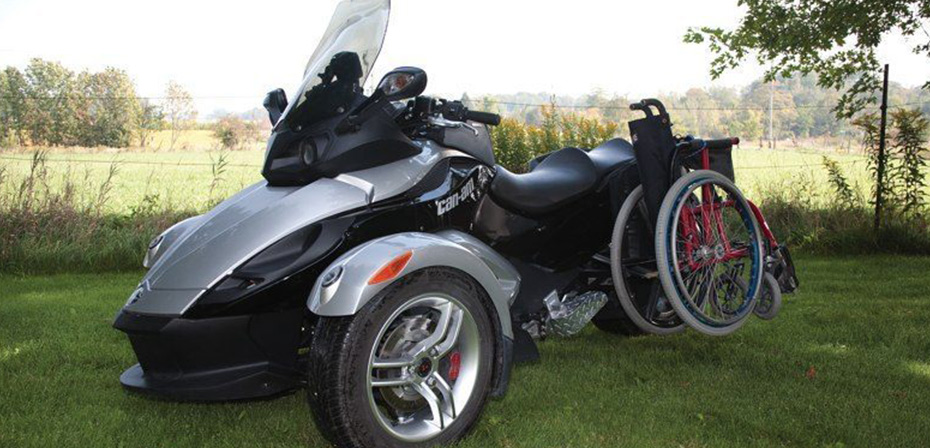Like most of us, Barnie Floto’s love of motorcycles started early. By the time he was 15, he was the proud owner of a new 1974 CB125 Honda. Being too young to be licensed didn’t keep Barnie from exploring the rural roads around his parent’s farm near Guelph, Ontario, once his homework and chores were completed.
Holding the appropriate documents by June of his sixteenth year, Barnie was free to venture far and wide. Unfortunately, only three months later a collision with a car left Barnie a paraplegic, and with much to think about. “At sixteen, I was too young to think of giving up and not mature enough to logically plan out a life for myself,” said Barnie. “A nine-month stay in hospital followed by two years of rehab gave me time to consider what the future might bring.”
The support of his family gave Barnie strength to move forward through this difficult time, but he found that he was drifting from his friends, as he was no longer in their school classes or on the ball field.
At this time, influencing Barnie’s still-burning motolust, older brother Fred took him down the path familiar to most guys with a succession of ATVs, snowmobiles and of course, cars. Never one to shy away from attention, Barnie’s first four-wheel purchase was a 1971 Hemi Cuda. In his own words, “If I had floundered trying to catch up with my friends, getting out in something that would pass them seemed the right thing to do.” This car brought the independence and freedom Barnie needed while showing, as throughout his whole life, he was up for the challenge.
Through hard work and determination, Barnie did catch up and graduated Grade 13 with the friends that he had started school with. Not one to be defined by his disability, Barnie got back to the ball field and has been playing baseball with the same group for the last 26 years. Obstacles continued to fall as Barnie took up golf, pick-up hockey and was one of the longest-serving trail wardens for the Ontario Federation of Snowmobile Clubs, logging over 3,000 km per season on his sled.
Something was still missing, though. The short time spent on his little Honda many years before had left a strong impression, and in the fall of 2001, with the moral support of his wife, he purchased a 1981 Goldwing with Velorex sidecar. With help from his brother and some friends, the Wing was ready to hit the road the way Barnie needed it set up. As is his style, Barnie took baby steps the first year with a solo five-day, 3,800-km circuit around Lake Huron and Lake Superior, and upon completion decided that he had found his next challenge to conquer. In Barnie’s words, “There is a real story in the fact that a guy in a wheelchair set a goal of circling each lake via motorcycle. I don’t know if any ‘walkie’ motorbike rider has done this, but I am quite sure that no other wheelchair-bound motorcyclist has ever done this.”
While the Wing had served well with over 60,000 km added to the clock, Barnie had a hankering for something a bit more sporty. “Now turning 50, I felt that my sledding days were past, but I could upgrade my motorbike,” and with that, the keys to his GSX 600 H.O. SDI Skidoo were hung up. The upgraded motorbike came in the form of the new Can-Am Spyder by BRP, which really appealed to the performance-minded Barnie. Comfortable-looking ergonomics and the resemblance in layout to his beloved sled sealed the deal, and the first Canadian deposit was made for a Spyder with his local dealer–Two Wheel Motorsports of Guelph.
While the basic layout of the Spyder suited Barnie’s needs well, several modifications had to be made. With the help of his machinist brother, Fred, design and construction of the floorboards and a rack for the wheelchair were soon underway. It was more of an engineering challenge to convert the brake system from foot-activated linked brakes to hand operation. Shifting was another issue to be addressed. Hand-operated ‘automatic’ shifting is now available on the Spyder, but the first year of production was clutch and foot-activated only. Barnie wasn’t willing to wait for a new model and prefers to handle shifting chores himself. Having seen electronic hand-activated shifters on drag bikes, Barnie set his mind to adapting one of these systems to his new ride.
Along the way, an unnoticed swingarm defect led to much head-scratching, as alignment was off enough to cause the toothed drive-belt to part company with the rear cog. Since it was a completely new product, figuring out the cause and correction was a daunting task. The “over the top” support and service offered by Two Wheel Motorsports’ service manager, Rich Kensworthy, and BRP saw the issue fixed and the first semi-automatic, hand-braked Spyder was on the road.
In 2008, more Great Lakes circuits were notched up on the Spyder with two days each around Lake Ontario and Lake Erie. At the time, the brand-new Spyder was still a rarely seen item on the road, and Barnie was regularly mobbed at gas stops along the way with well-wishers genuinely happy to meet a guy who, through dint of personality and sheer determination, surmounted his challenges. “I get a lot of walk-up traffic asking questions. I love to chat about the Spyder, especially about it being a Canadian design, made in Canada, by Canadians. The handling of the Spyder is awesome; power steering makes long rides effortless. I’ve clocked 1,100- and 1,300-km days with no comfort issues. The Spyder is a hot rod with 110 horsepower and 80 foot-pounds of torque, it really hauls. It’s the presence of a wheelchair that inspires thought in people’s minds, saying disabled folks can accomplish much more than they thought.”





















